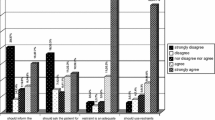Abstract.
The aim of the study was to analyse the use of holding, restraints, seclusion and time-out in child and adolescent psychiatric in-patient treatment in Finland. The study included 504 child and adolescent psychiatric in-patients in the year 2000. Time-out had been used for 28 %, holding for 26 %, seclusion for 8 %, and mechanical restraints for 4 % of the in-patients. In multivariate analysis, aggressive acts were the strongest factor associated with all kinds of restraint practices. Psychosis, suicidal acts and older age (13–18 years) were associated with seclusion and mechanical restraints. Younger age (< 13 years), attachment disorder and autism were associated with holding. The longer children had been in treatment, the more likely they were to have been restrained. The high prevalence of restraint techniques used indicates a need for guidelines of restraint and seclusion which take into account the child's need for protection from his/her own impulses and the legal rights of the child.
Similar content being viewed by others
Author information
Authors and Affiliations
Additional information
Accepted: 22 February 2002
Correspondence to: A. Sourander
Rights and permissions
About this article
Cite this article
Sourander, A., Ellilä, H., Välimäki, M. et al. Use of holding, restraints, seclusion and time-out in child and adolescent psychiatric in-patient treatment. European Child & Adolescent Psychiatry 11, 162–167 (2002). https://doi.org/10.1007/s00787-002-0274-2
Issue Date:
DOI: https://doi.org/10.1007/s00787-002-0274-2




